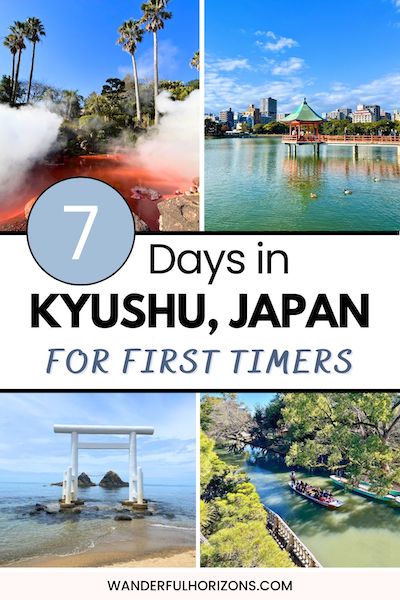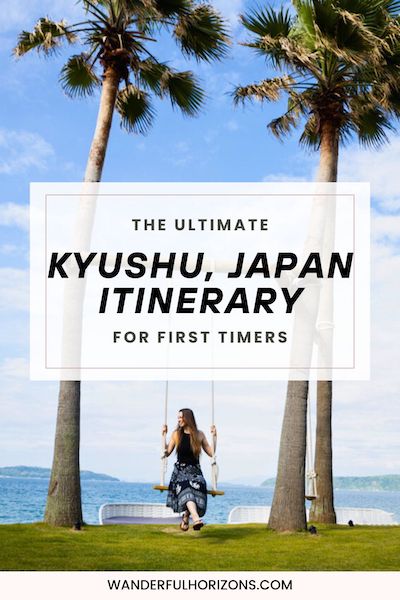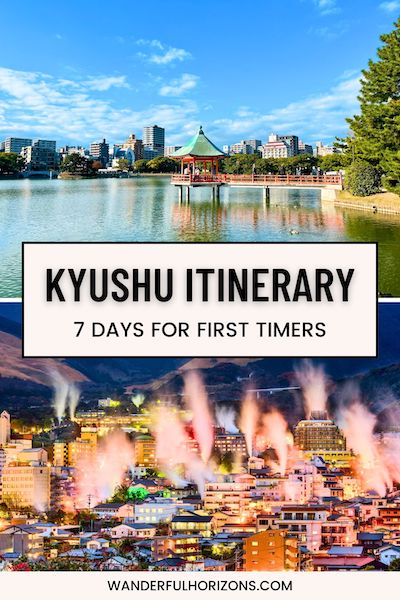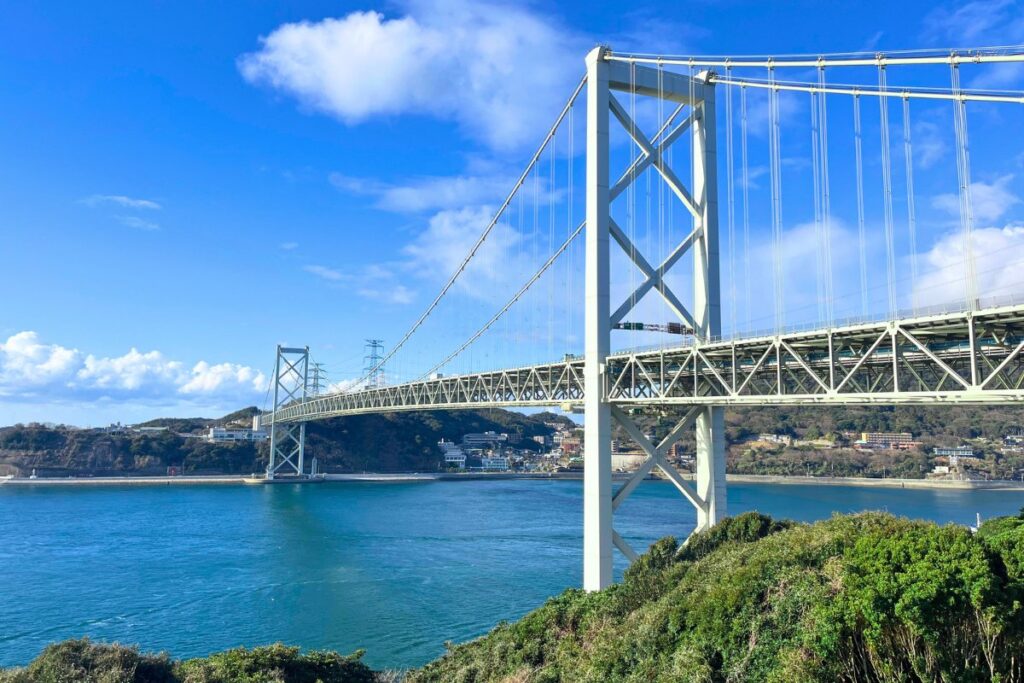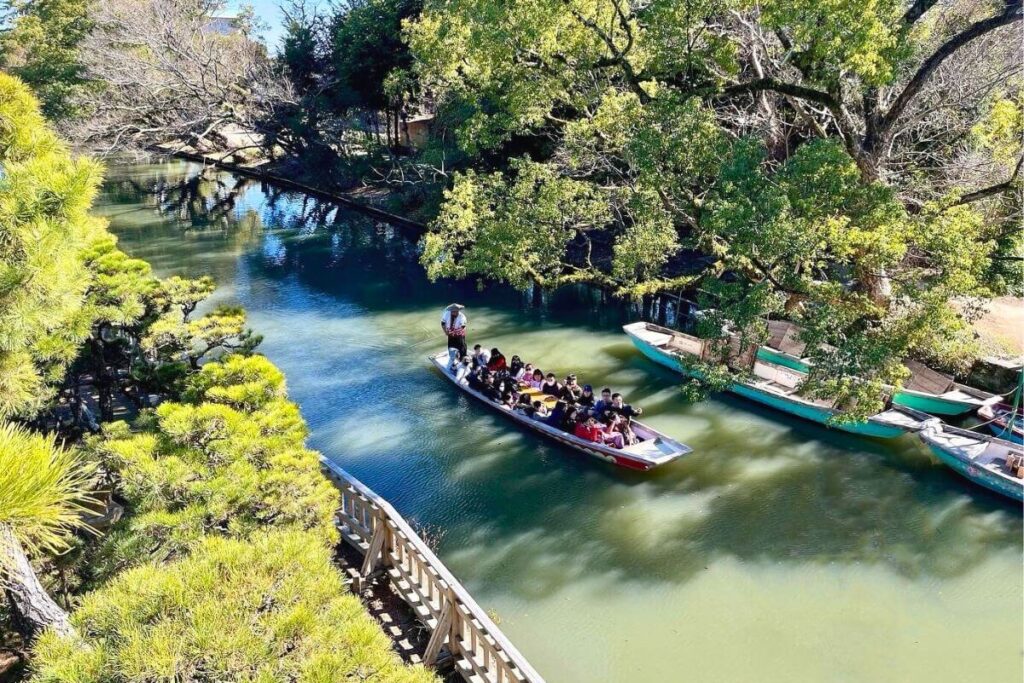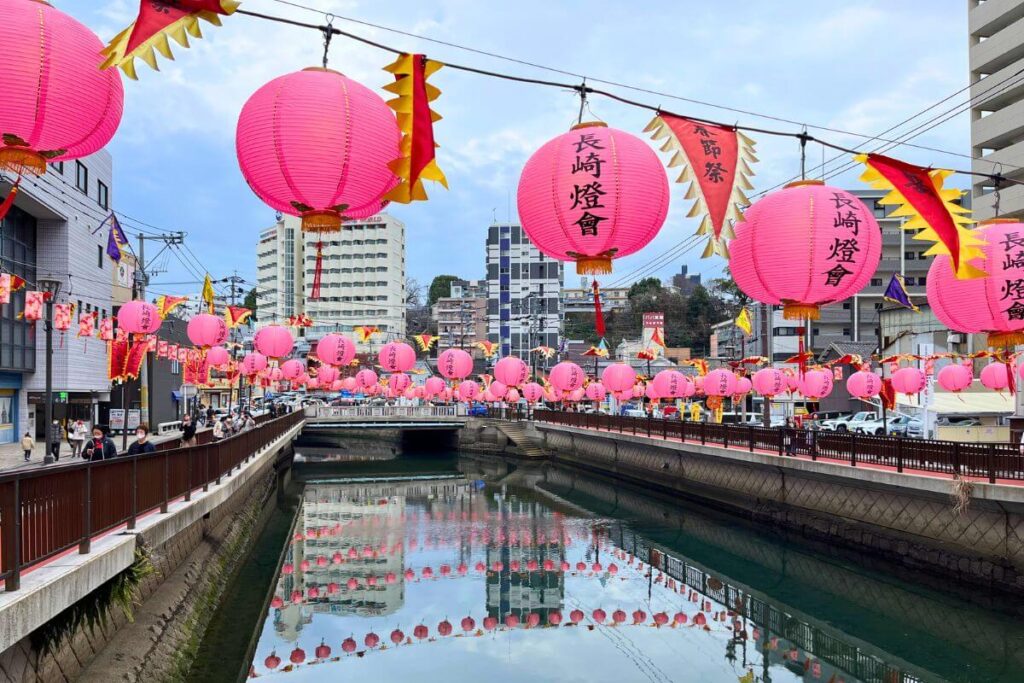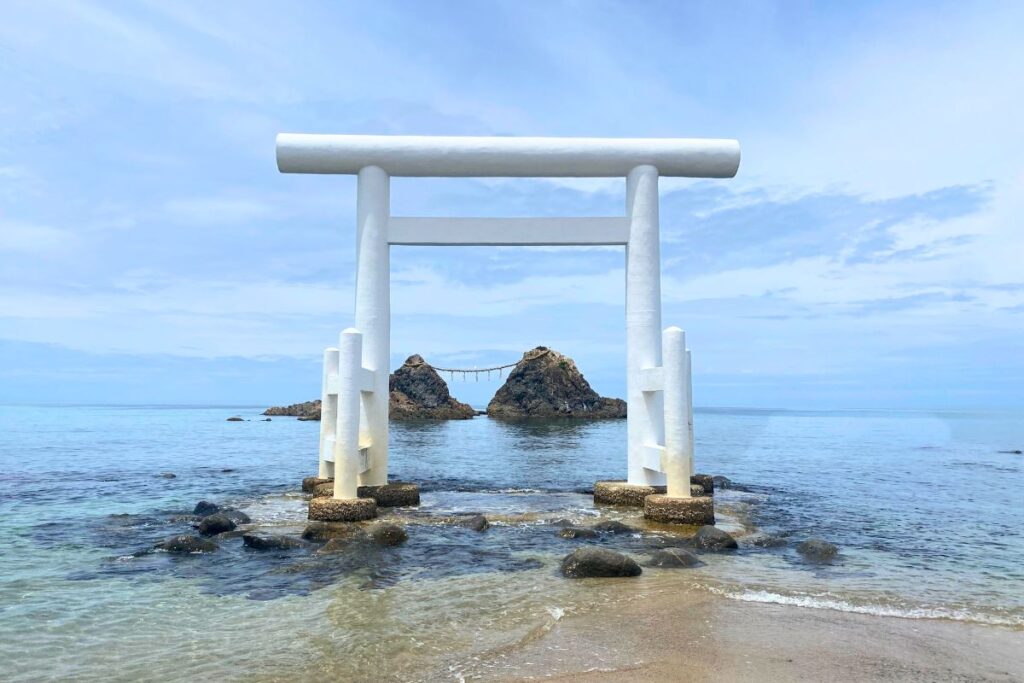
Planning your first trip to Kyushu, Japan? Don’t worry! I’ve got you covered with this unforgettable 7 day Kyushu Itinerary.
Renowned for its natural beauty and cultural richness, Kyushu is home to an array of stunning landscapes.
From picturesque hot springs to smoldering volcanoes, pristine beaches, majestic mountains, and lively historical cities, the island truly has something to offer everyone.
In fact, there’s so much to do and see here that planning your first trip to Kyushu can be a bit overwhelming – I get it, I’ve been there!
Luckily for you, I’ve had the opportunity to visit the island several times and have put together the perfect itinerary.
From Beppu to Fukuoka and Nagasaki (with lots of day trips thrown in), we’ll hit up the island’s most popular attractions and take in its most famous sites.
That being said, here’s everything you need to know to plan your first-time Kyushu itinerary for 7 days.
*Please note: This post contains affiliate links to trusted partners. If you make a purchase using these links, I will earn a commission at no extra cost to you. Thank you for your support!
Planning a last-minute trip to Kyushu?
Here are a few quick recommendations for you!
I suggest booking these services and activities in advance!
🚅 Getting There/Around:
– Japan Rail Pass (Great option if you plan to travel all over Japan)
– Individual Shin Tickets (Will likely be cheaper if you don’t plan to visit many cities)
– Private Airport Transfers (For those who prefer to travel by car)
♨️ Beppu:
– Super Hotel Beppu Ekimae (Mid-range hotel in a great location near the train station)
– 7 Hells of Beppu (Discounted combo pass for all 7 hot springs!)
– Guided Tours of Beppu (There are lot of options to explore!)
🏙️ Fukuoka:
– The Lively Fukuoka Hakata (Mid-range hotel in the heart of the city)
– Fukuoka Tower (Pre-book admissions tickets)
– teamLab Forest (Pre-book admissions tickets)
– Guided Day Trips from Fukuoka (There are lot of options to explore!)
🏮 Nagasaki:
– Hotel Forza Nagasaki (Mid-range hotel in the heart of the city)
– Nagasaki Atomic Bomb Museum (Pre-book admissions tickets)
– Glover Garden (Pre-book admissions tickets)
– Huis Ten Bosch (Pre-book admissions ticket – Great day trip option!)
Best Time to Visit Kyushu
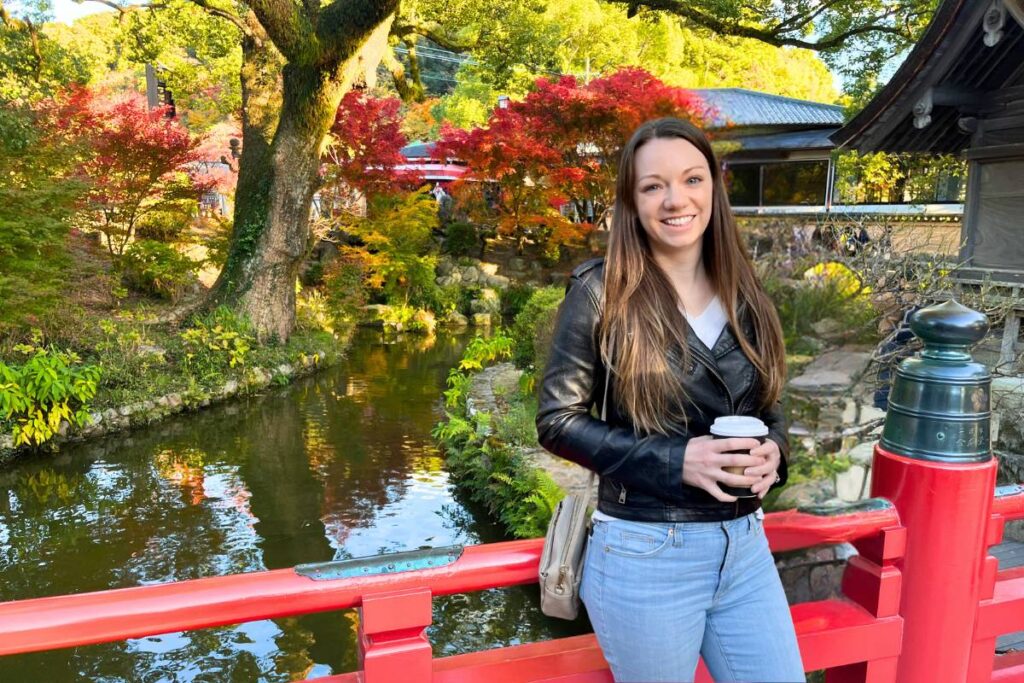
Fall is a great time to visit Kyushu!
Given the island’s location in the southern region of Japan, Kyushu is a great destination to visit pretty much any time of the year.
That being said, if I had to choose a specific season, I’d recommend either spring or fall.
Both of these seasons offer great weather with minimal rain. And on top of that, you’ll be greeted with incredibly scenic landscapes – think cherry blossoms and fall foliage.
The only downside to all of this is the crowds you’re likely to encounter, especially during cherry blossom season.
While Kyushu is usually less crowded than other areas of Japan, spring and fall are peak travel season for local and domestic tourists.
If you wish to avoid this, you could instead travel to Kyushu in the winter.
Although temperatures will be a bit on the cooler side, it won’t be as cold as the main island of Honshu. So, you can still get out and comfortably explore.
In addition to this, you’ll generally find that travel costs are cheaper during the winter months.
And finally, we have summer – which is the season I’d least recommend. Unless of course, your plan is to simply visit the beach.
See, summers in Japan are not only incredibly hot, but they also mark the start of typhoon season.
And, unfortunately, Kyushu is known to get hit by a couple of typhoons every year.
While typhoon season technically runs from May to October, the most active months for storms are August and September.
A Note on Japanese Holidays
Japan has a few major national holidays that significantly impact travel. These include Golden Week (end of April – beginning of May), Silver Week (mid-September), and New Year. Around these holiday periods, domestic travel peaks, prices increase significantly, and businesses may temporarily close down. Given this, I generally recommend, if at all possible, that visitors avoid travel to Japan during these times.
How to Get to Kyushu
The island of Kyushu lies just south of Honshu, Japan’s main island, and is connected to many of the country’s major cities via train.
There are also numerous international airports located across the island, including Fukuoka Airport, Oita Airport, Saga Airport, Nagasaki Airport, Kumamoto Airport, Kagoshima Airport, and Miyazaki Airport.
This makes it quite easy to reach Kyushu, regardless of where you’re traveling from.
For the purposes of this itinerary, we’ll begin our travels in the city of Beppu. So I recommend either flying into Oita Airport (OIT) or you can take the train to Beppu Station.
How to Get Around Kyushu
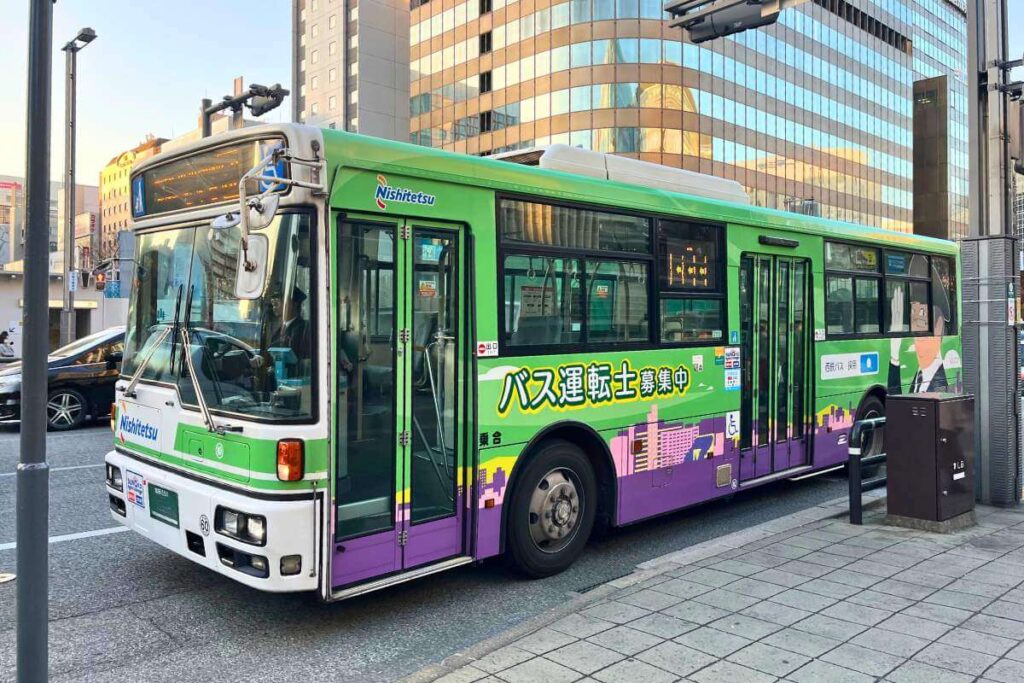
Public buses are common in Kyushu.
All of the destinations mentioned in this 7 day Kyushu itinerary are accessible via train. This means you can easily hop from city to city using the Japan Rail Pass.
Or, alternatively, you can drive, if you’d like to have a bit more freedom and flexibility with your schedule.
Meanwhile, transportation within the cities is very convenient and accessible as well.
Although each destination varies slightly, they all offer some combination of buses, trains, subways, and trams.
To utilize these methods of transportation, it’s best to purchase an IC card, which is essentially a prepaid, refillable transportation pass.
These passes can be purchased at the train station and are accepted on most forms of local transportation across Japan.
Pro Tip: To help you navigate your way through Kyushu (whether by car or public transit), I suggest using Google Maps. This app is one of the best travel apps for Japan, as it syncs with local public transportation and provides accurate, up-to-date transit information.
Driving in Japan
Before you rent a car in Japan, make sure you look into the Japanese license requirements specific to your home country. Depending upon where you reside, you might need to obtain an International Driver’s Permit, a translated copy of your home country’s driver’s license, or, in some specific cases, a Japanese driver’s license.
For those traveling from the United States, Canada, Australia, Singapore, and most European countries, an International Driver’s permit is required. You can obtain this from an authorized automobile association in your home country.
Map of Kyushu
To help you plan your trip, here’s a quick map overview of all the destinations mentioned in this 1 week Kyushu itinerary.
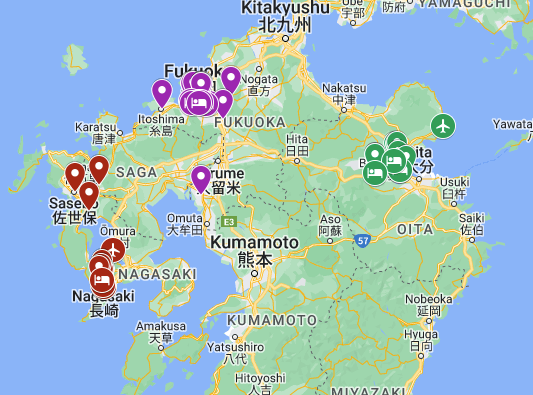
If you’d like to view an interactive version of this map, click here!
Kyushu 7 Day Itinerary: An Overview
Don’t have time to read the article in full? Here’s a quick recap of my suggested itinerary for 7 days in Kyushu.
- Day 1 – Beppu: Arrive in Beppu & explore the city’s onsens.
- Day 2 – Beppu: Visit Beppu’s parks & spend time in Yufuin.
- Day 3 – Fukuoka: Travel to Fukuoka & discover the city’s historical sites.
- Day 4 – Fukuoka: Explore the city’s temples & shrines, visit Canal City.
- Day 5 – Fukuoka: Take a day trip to Dazaifu, Itoshima, or Yanagawa.
- Day 6 – Nagasaki: Travel to Nagasaki & explore the city’s main highlights.
- Day 7 – Nagasaki: Take a day trip to Huis Ten Bosch, Arita, or Sasebo.
Kyushu 7 Day Itinerary: Explained
On that note, let’s dive right in and discuss in detail the perfect Kyushu itinerary for 7 days. I’ve included several activities and day trips for you to choose from. So, feel free to pick and choose and adapt this itinerary as you see fit!
Stop 1: Beppu, Japan – 2 Days
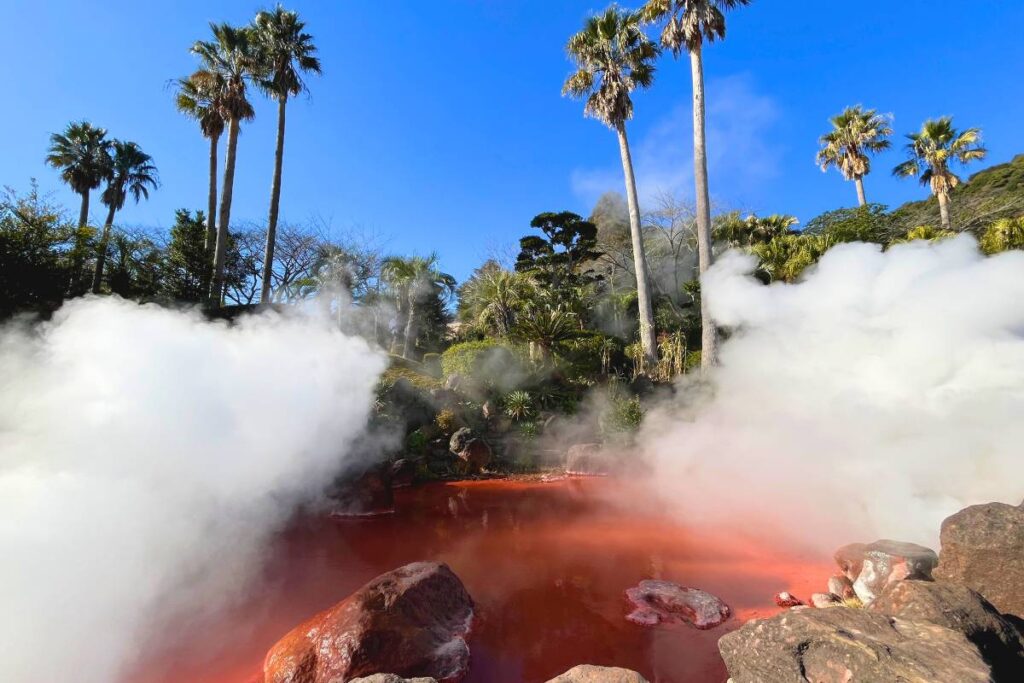
An onsen at Umi Jigoku, part of the 7 Hells of Beppu.
Dubbed the Onsen Capital of Japan, Beppu is renowned for its vibrant hot springs, also known as onsens. These stunning natural wonders, which number in the thousands, are among the most famous in all of Japan.
However, the city of Beppu has much more to offer than just its thermal waters. Here, you’ll also find stunning ocean views, serene bamboo forests, abundant wildlife, and delectable local cuisine.
Thankfully, for this itinerary, you’ll have two days to explore all of this and more.
I recommend spending your first day in the city center, where you’ll find Beppu’s most striking onsens. Then, on your second day, you can venture beyond Beppu and discover the charming town of Yufuin.
How to Get to Beppu
As shared above, the easiest way to reach Beppu is to either fly into Oita Airport (OIT) or take the train to Beppu Station.
For those flying in, Oita Airport is situated about 50 kilometers up the coast in the city of Oita.
To get from the airport to Beppu, I recommend either taking the public bus, hiring a taxi, or booking a private transfer.
There is also a train that you can take to Beppu Station. However, the closest train station to the airport, Kitsuki Station, is located about 30 minutes away. So, it can be a bit inconvenient – as you’ll first need to take a taxi or a bus and then hop on the train.
If you decide to do this, be sure to take the limited express train from Kitsuki Station to Beppu Station, as this is the fastest option.
Meanwhile, for those traveling from nearby cities, Beppu is connected via rail to a number of other popular destinations.
For example, the train ride from Osaka to Beppu takes approximately 4 hours. From Hiroshima, it’s around 2 and a half hours. And from Fukuoka, it takes about 2 hours.
Best Things to Do in Beppu
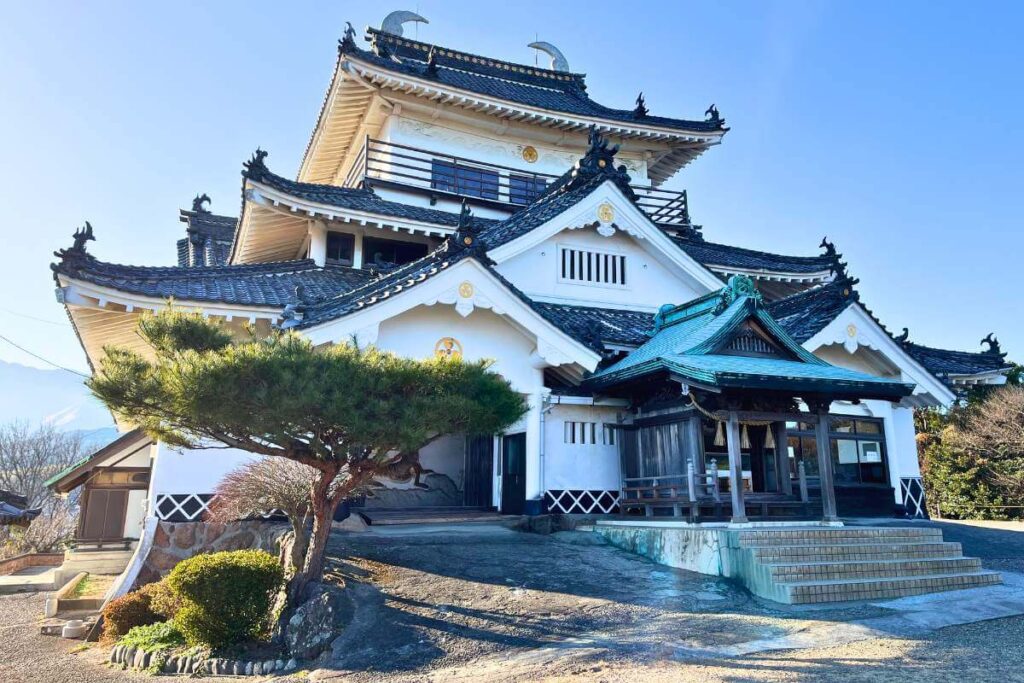
Kifune Castle in Beppu.
Here are some of the most popular things to do in Beppu:
- Experience Beppu’s Onsens: The 7 Hells of Beppu are the city’s most famous onsens. While they are not open for swimming, they are incredibly beautiful to behold and well worth checking out. Meanwhile, for those who’d like to actually take a dip in the hot springs, there are several onsen facilities spread throughout the city. The one that I recommend is Hyotan Onsen, which is the only three-star Michelin onsen in Japan.
- Sample Hell-Steamed Cuisine: Unique to Beppu, Hell-Steamed cuisine is a cooking method that uses steam from the onsens to heat up food. While some vendors offer smaller snacks like eggs, sweet potato, and corn, there are also sit-down restaurants where you can get a full meal – all cooked using the onsens’ steam. One of the more popular restaurants for this is Jigoku Mushi Kobo Kannawa.
- Discover Kifune Castle: Recently rebuilt in the 1950s, Kifune Castle offers incredible views overlooking Beppu City. Here, you can take a guided tour to learn more about the castle and you may even get to meet its official guardian, an albino python.
- Explore Beppu’s Parks: Beppu is home to two noteworthy parks – the Beppu Park and the Takasakiyama Natural Zoological Garden, also known as Beppu’s Monkey Park. As you may have guessed, the Zoological Garden is most famous for its wild Japanese macaque monkeys (aka snow monkeys), which are known to frequent the area. Meanwhile, Beppu Park is a beautiful public park where you’ll find a small bamboo grove, several stunning cherry trees, and a variety of flowers.
- Venture Over to Yufuin: Situated 35 kilometers inland, Yufuin is a small town known for its onsens and fairytale-like attractions. Here, you’ll find the whimsical Floral Village, which was inspired by Harry Potter. As well as a variety of souvenir shops, family-run restaurants, relaxing onsen hotels, and stunningly scenic views (especially on the drive over!).
Where to Stay in Beppu
When I visited Beppu, I personally stayed near Beppu Station, which resides right in the heart of the city.
This is a great location to base yourself out of, as you’ll have easy access not just to public transportation, but also to a variety of amenities. This includes a wide offering of hotels, as well as numerous restaurants, bars, and cafes.
Furthermore, I found the area to be a bit more laid-back and low-key than other more touristy parts of the city.
Aside from this, a few other popular places to stay include:
- Kannawa: Offering easy access to the city’s onsens, the district of Kannawa encompasses five of Beppu’s seven hells. In addition to this, the area is home to several high-end hotels, traditional ryokans, and Airbnb rentals.
- Yufuin: Known for its laid-back and peaceful atmosphere, Yufuin is popular among those who prefer to avoid the crowds. What’s more, the town offers several accommodations that feature private onsens.
🌟 For a more detailed guide to Beppu, be sure to check out my 2 day Beppu itinerary!
Stop 2: Fukuoka, Japan – 3 Days
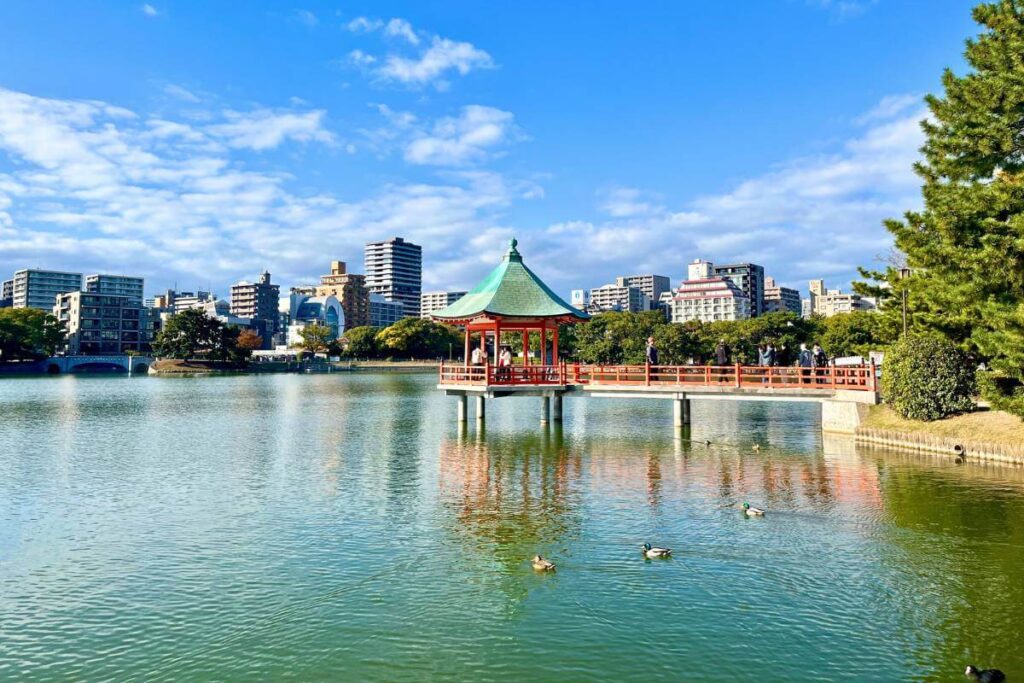
Ohori Park in Fukuoka City.
The next stop on our journey is Fukuoka, Kyushu’s largest and most famous city.
Known for its rich history, lively nightlife, incredible local cuisine, and beautiful natural surroundings, Fukuoka is a must for any visitor to Kyushu.
While three days may seem like a lot of time to spend in just one place – Fukuoka has a lot to offer. So trust me, when I say it’s worth it!
For this itinerary, I recommend dedicating 2 days to exploring the city. Then, on your third day, you can venture out for a day trip to a nearby destination.
How to Get to Fukuoka
The fastest and easiest way to get from Beppu to Fukuoka is via the limited express train.
This train departs from Beppu Station and travels to Hakata Station, which is the main train station for Fukuoka.
The train ride is direct, with no transfers, and takes about 2 hours in total.
Alternatively, you can also drive, if you have a rental car. The drive time between the two cities is roughly 2 hours as well, depending upon traffic.
Best Things to Do in Fukuoka
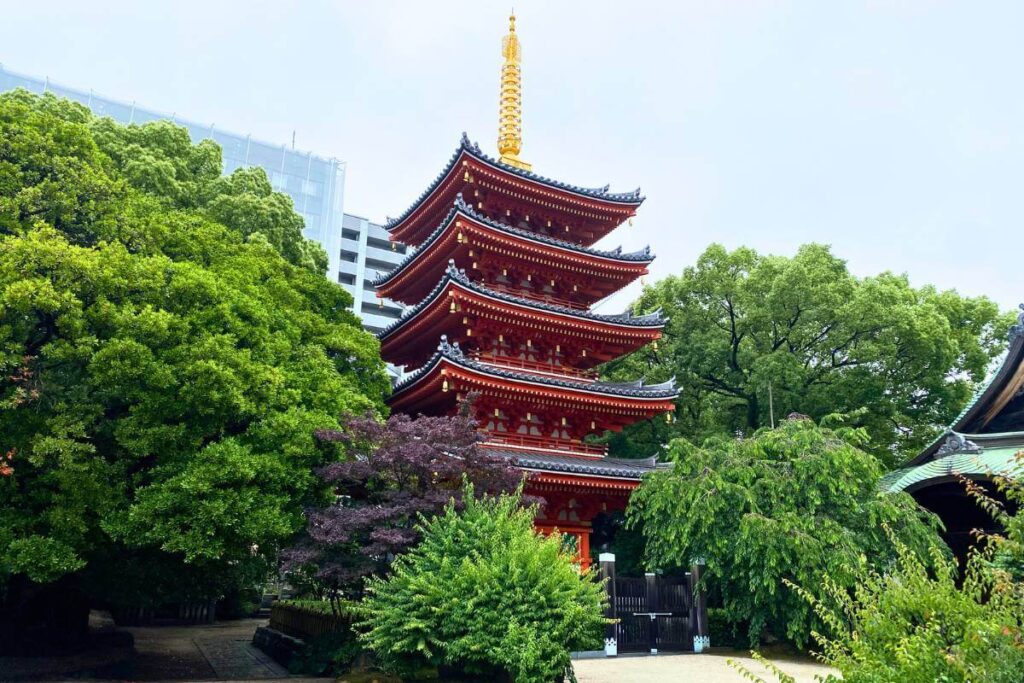
The pagoda at Tochoji Temple in Fukuoka.
Here are some of the best things to do in Fukuoka:
- Explore Fukuoka’s Castle Ruins: Dating back to the 17th century, Fukuoka Castle used to be one of the largest and most important castles on the island of Kyushu. Although most of it lies in rubble today, there are still a few buildings left that you can visit. While you’re here, be sure to also check out Ohori Park (which once served as the castle’s moat) and the Ohori Park Japanese Garden. There’s also the Gokoku Shrine, and the Fukuoka Art Museum, both of which are located nearby.
- Spend Time By the Sea: As a seaside city, Fukuoka offers incredible coastal views. You can admire and take in these views from Fukuoka Tower and/or Momochi Seaside Park (which is home to an artificial beach). Located nearby, you’ll also find teamLab Forest and the Fukuoka City Museum.
- Visit the City’s Temples & Shrines: Fukuoka is home to a number of historic shrines and temples that are definitely worth checking out! A few of my favorites include Tochoji Temple, Kushida-jinja Shrine, and Sumiyoshi Shrine. There’s also Nanzoin Temple, which is famous for its large reclining Buddha statue.
- Discover Canal City: Built around an artificial canal, Canal City is a five-story entertainment complex known for its nightly water shows. Here, you’ll find several shops, bars, and restaurants, including the famous food court, Ramen Stadium. Meanwhile, right across the street lies the city’s popular Yatai Food Stalls. These small portable restaurants serve up a variety of delicious local cuisines.
- Head Out On a Day Trip: The city of Fukuoka is surrounded by several incredible destinations, so venture out on a day trip and explore one of them! There’s Yanagawa, famous for its picturesque canals. Or the historic city of Dazaifu, once called the “Western Capital of Japan.” And finally, Itoshima, a hidden beach getaway known for its white sandy beaches and blue-green waters.
Where to Stay in Fukuoka
The best places to stay in Fukuoka, in my opinion, are either Hakata Ward or Tenjin Area.
Both of these areas are centrally located in the heart of Fukuoka and offer easy access to public transportation as well as a number of establishments.
From restaurants to shops, bars, cafes, shopping malls, hotels, and even some of the city’s most famous attractions – you can find just about everything.
That being said, there are a few other areas that are worth mentioning:
- Sawara Ward: Home to the neighborhoods of Momochihama and Nishijin, Sawara Ward encompasses some of the city’s most famous attractions. This includes Fukuoka Tower, Momochi Seaside Park, Fukuoka Castle, and Ohori Park. On top of this, the area is known to be very family-friendly and is generally less crowded than downtown Fukuoka.
- Nakasu Island: Situated on an island within Hakata Ward, Nakasu is the place to stay if you’re interested in exploring Fukuoka’s nightlife. Here, you’ll find a large concentration of bars, clubs, and restaurants, as well as the city’s most popular entertainment district.
- Daimyo: Located within Chuo Ward, Daimyo is known for its young, hip, and trendy vibes. Offering a more laid-back atmosphere, the area is home to several vintage shops, boutique stores, local cafes, and bars.
🌟 For a more in-depth guide to Fukuoka, be sure to check out my 3 day Fukuoka itinerary!
Stop 3: Nagasaki, Japan – 2 Days
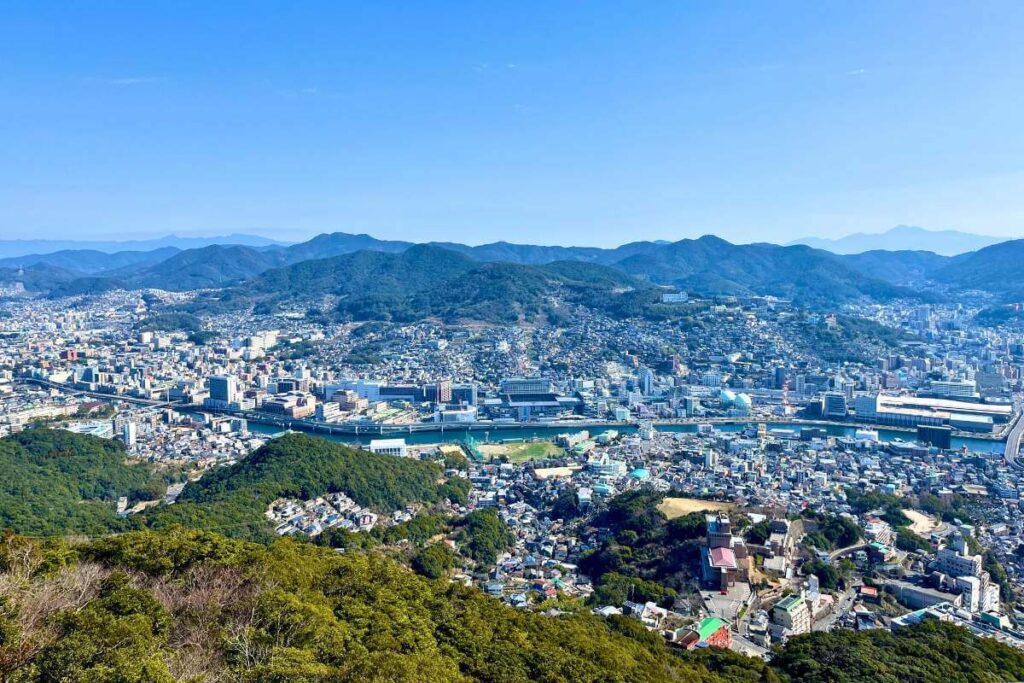
View of Nagasaki from Mt. Inasayama Observatory.
Next up and the final stop on our itinerary is Nagasaki, a city known for its tragic past and vibrant future.
While Nagasaki was destroyed during the bombings of WWII, it has since rebuilt itself and is now thriving as a multicultural metropolitan city.
Here, you’ll find stunning coastal views, lively traditional festivals, delectable local cuisine, and a diverse cultural atmosphere.
During your two days in Nagasaki, I recommend spending one day in the downtown area and one day venturing out to a nearby destination. This will allow you the chance to explore not just the city, but its incredible surroundings as well.
How to Get to Nagasaki
To get from Fukuoka to Nagasaki, you can either drive or take the train.
While driving takes about 2 hours, the train can take as little as an hour and a half.
If you opt to travel by train, there’s a limited express train that you can ride from Hakata Station to Takeo-Onsen Station.
Once you arrive at Takeo-Onsen Station, you can then transfer to the bullet train bound for Nagasaki Station.
Best Things to Do in Nagasaki
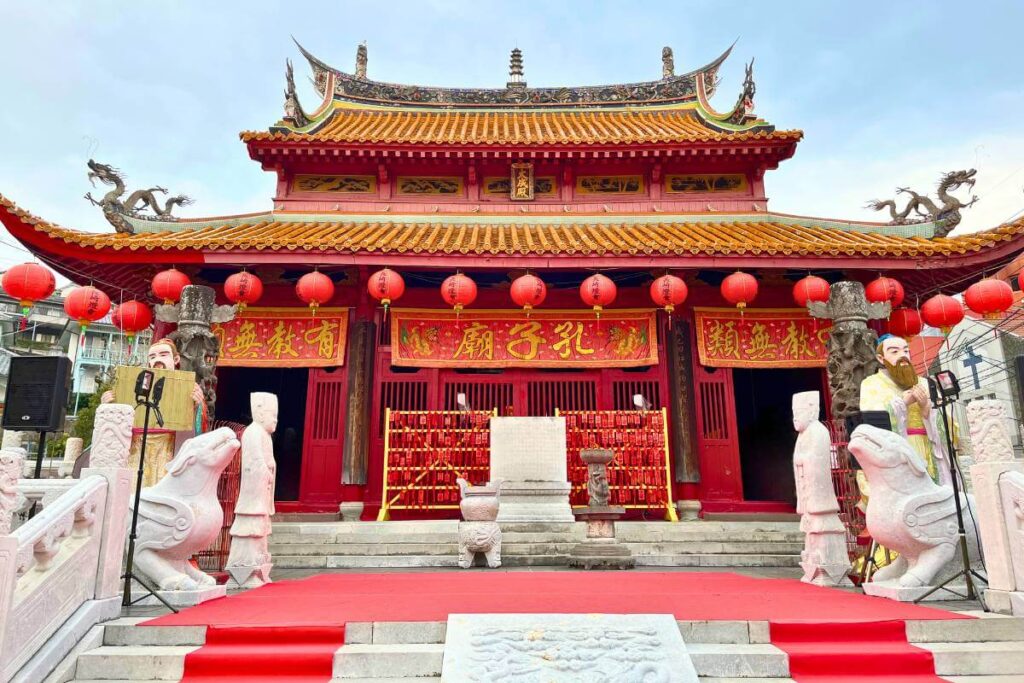
The Koshibyo Confucius Shrine in Nagasaki.
Here are some of the most notable things to do in Nagasaki:
- Visit Nagasaki’s Atomic Bomb Museum: Built in remembrance of WWII, the Atomic Bomb Museum sheds light on the city’s tragic bombing. Next to it, you’ll also find the Nagasaki Peace Park and the Hypocenter Park, both of which feature a variety of monuments and statues dedicated to peace.
- Discover Shinchi Chinatown: Dating back to the 1600s, Shinchi is the oldest and one of the largest Chinatowns in Japan. The area is known for its fusion restaurants, street vendors, and lively festivals. While you’re here, be sure to also head south and visit the Nagasaki Koshibyo Confucius Shrine, one of Japan’s few Confucius shrines.
- Explore Minami Yamate Hillside: Once home to European merchants, Minami Yamate is a historic foreign settlement that has been preserved over time. The area is home to several notable attractions including Glover Garden and Oura Cathedral, which is a UNESCO World Heritage Site.
- Take in the Views from Mt. Inasayama Observatory: Situated 333 meters above sea level, Mt. Inasayama Observatory is renowned for its 360-degree views of Nagasaki. In fact, it’s been recognized as offering one of the best nighttime views in the entire world. The observatory can be reached via public bus, car, or ropeway.
- Go for a Day Trip: Nagasaki is surrounded by several incredible destinations, so venture beyond the city and take a day trip! There’s Huis Ten Bosch, the Dutch-inspired theme park. Or the city of Sasebo, known for its countless islands. And finally, Arita, the Porcelain Capital of Japan.
Where to Stay in Nagasaki
During my trip to Nagasaki, I stayed in the Dozamachi area, and found it to be a great location!
It’s centrally situated within the city, so access to public transportation is readily available – which means it’s very easy to get around.
On top of that, there are a wide variety of shops, bars, and restaurants in the area.
Aside from this, a few other noteworthy places to stay include:
- Nagasaki Station: If you’re really short on time or have an early train to catch, the area around Nagasaki Station is a great option. And there just so happens to be a wide variety of hotels to choose from here.
- Hiranomachi: Located close to the Atomic Bomb Museum, Hiranomachi is a bit quieter and a bit more laid back. While hotel options are limited, the area does offer easy access to several popular attractions.
🌟 For a more complete guide to Nagasaki, be sure to check out my Nagasaki day trip itinerary.
More Than 7 Days in Kyushu
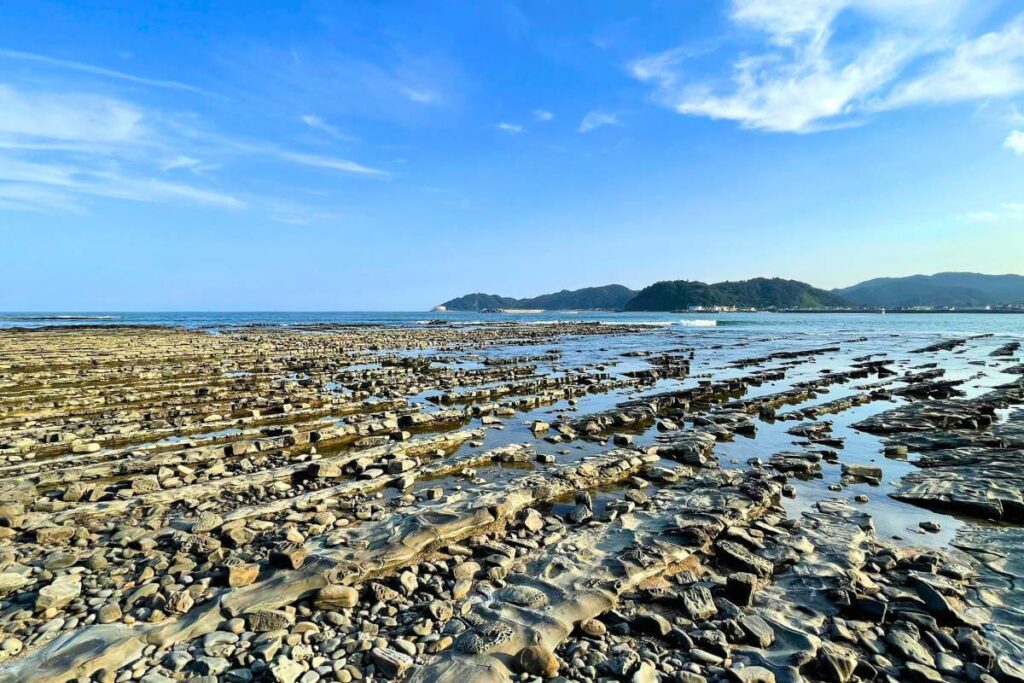
Photo of Aoshima Island by Akito via Unsplash.
Interested in adjusting this 7 day Kyushu itinerary? Or maybe you’re contemplating a longer stay? If so, consider visiting some of these other popular destinations as well!
- Kumamoto: Known for its rich cultural heritage and abundant onsens, the city of Kumamoto is a perfect addition if you’d like to spend a few extra days in Kyushu. Popular attractions here include Kumamoto Castle, Suizenji Garden, and Reigando Cave. Be sure to also take a day trip over to Mount Aso, Japan’s largest active volcano.
- Miyazaki: The prefecture of Miyazaki is home to a variety of attractions and natural wonders. While Takachiho Gorge is, undoubtedly, the most famous, other notable points of interest include Aoshima Island, Miyazaki City, and Mount Osuzu.
- Kagoshima: Situated on the southern tip of Kyushu, Kagoshima Prefecture is renowned for its active volcanoes, pristine islands, and incredible ocean views. Popular destinations here include Kagoshima City, Yakushima Island, and the Amami-Oshima Islands.
Frequently Asked Questions About Planning a Kyushu, Japan Itinerary
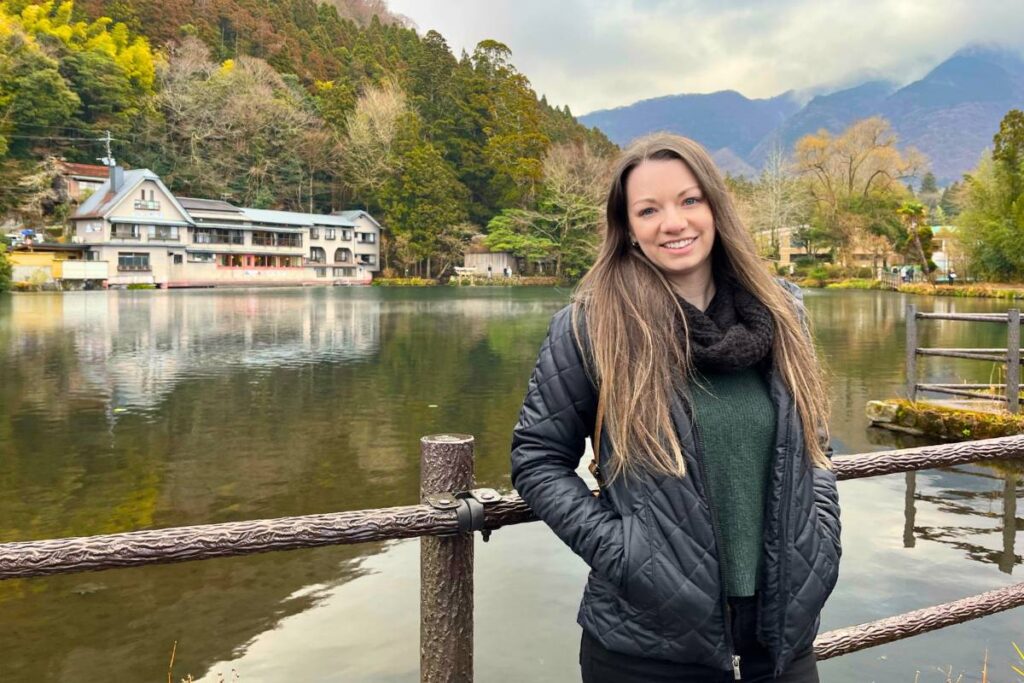
At Kirin Lake in Yufuin.
Here are my thoughts on some commonly asked questions about Kyushu travel.
Is Kyushu Worth Visiting?
Most definitely! In fact, it’s one of my favorite islands in Japan! There’s just so much to do and see here. And, the best part is it’s not nearly as crowded as the main island of Honshu. From its historical cities to its incredible natural scenery and its rich culture, Kyushu is a spectacular destination!
What Is Kyushu Best Known For?
As the “Land of Fire,” Kyushu is most known for its natural wonders – which are many! From active volcanoes to smoldering hot springs, majestic mountains, cascading waterfalls, and stunning beaches, the landscape here is absolutely incredible!
How Many Days Do You Need for Kyushu?
Kyushu is a large island – so you could easily spend weeks exploring it all. That being said, a well-planned 7 day itinerary should provide you with more than enough time to visit the most popular highlights and get a feel for the culture. If your schedule allows, though, I do recommend extending your stay to 10-14 days. This will give you a better chance to more fully immerse yourself and experience all that this remarkable island has to offer.
Is It Easy to Travel Around Kyushu?
Much like the rest of Japan, Kyushu is well connected via public transportation. So traveling around the island, especially to the larger cities, is very easy to do – even without a car. That being said, some destinations do lie a bit off the beaten path. And while it’s possible to reach them via public transport, sometimes it’s faster and more convenient to do so with a car or on a guided tour.
Is Kyushu a Tourist Friendly Destination?
Yes, Kyushu is definitely a tourist-friendly destination. Like the rest of Japan, the locals are welcoming and friendly towards foreigners. However, I will say that because it’s a bit off the beaten path, you are more likely to run into people who don’t speak English. So, be sure to brush up on some basic Japanese and have your favorite translation app downloaded and ready to go.
Final Thoughts: Kyushu Itinerary 7 Days
So there you have it – my top recommendations for a first-time 7 day Kyushu itinerary! Hopefully, this guide is helpful in planning your own trip to Japan’s Land of Fire.
Regardless of where you decide to go, you’re bound to have a memorable time. After all, Kyushu is an incredible destination – one that offers a unique glimpse into Japan’s rich culture and natural beauty.
Planning your own 7 day Kyushu itinerary? What are you most excited to do? Let me know in the comments below!
Love this Kyushu itinerary for 7 days? Pin it now for later!
